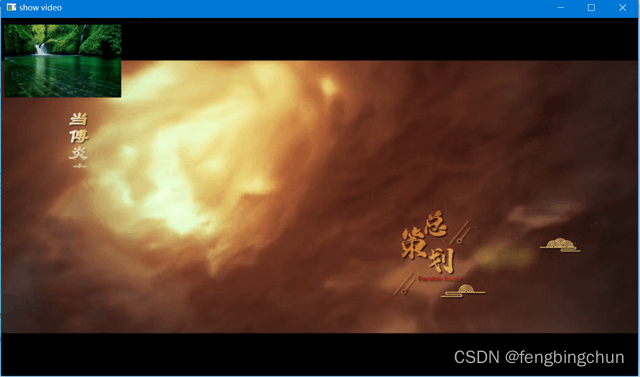FFmpeg中avfilter模块的介绍与使用
FFmpeg中的libavfilter模块(或库)用于filter(过滤器), filter可以有多个输入和多个输出。为了说明可能发生的事情,考虑以下filtergraph(过滤器图):

该filtergraph将输入流(stream)分成两个流,然后通过crop过滤器和vflip过滤器发送一个流,然后将其与另一个流合并。 可以使用以下命令来实现:
ffmpeg -i INPUT -vf "split [main][tmp]; [tmp] crop=iw:ih/2:0:0, vflip [flip]; [main][flip] overlay=0:H/2" OUTPUT
结果是将视频的上半部分镜像(mirrored)到输出视频的下半部分:
(1).同一线性链(same linear chain)中的过滤器用逗号分隔,不同线性链中的过滤器用分号分隔。此示例中,crop、vflip位于一个线性链中,split和overlay分别位于另一线性链中。
(2).线性链的连接点用方括号内的名称来标记,此示例中,split filter生成两个与标签[main]和[tmp]相关联的输出。
(3).发送到split的第二个输出(标记为[tmp])的流,通过crop过滤器进行处理,crop掉视频的下半部分,然后垂直翻转(vertically flipped)。
(4).overlay(覆盖或叠加)过滤器接收split过滤器的第一个未改变的输出(标记为[main]),并在其下半部分overlay由crop,vflip过滤器链生成的输出。
(5).某些过滤器接受输入参数列表:它们在过滤器名称和等号之后指定,并以冒号彼此分隔。
(6).存在没有音频/视频输入的所谓源过滤器(so-called source filters),以及没有音频/视频输出的接收器(sink)过滤器。
graph2dot:FFmpeg工具目录中包含的graph2dot程序可用于解析filtergraph描述,并用点语言(dot language)发出相应的文本表示。
filtergraph:
(1).过滤器图是连接过滤器的有向图。它可以包含循环,并且一对过滤器之间可以有多个链接(multiple links)。每个链接的一侧都有一个输入板(input pad),将其连接到从中获取输入(input)的一个过滤器,另一侧有一个输出板(output pad),将其连接到接受其输出(output)的一个过滤器。
(2).过滤器图中的每个过滤器都是在应用程序中注册的过滤器类的一个实例(an instance of a filter),它定义了过滤器的功能(features)以及输入和输出板的数量。
(3).没有输入板的过滤器称为"source",没有输出板的过滤器称为"sink"。
注:以上内容主要来自于:http://ffmpeg.org/ffmpeg-filters.html
以下为测试代码:将一幅图像叠加在视频上,类似于为视频添加logo
1.函数open_input_file:
int open_input_file(const char* filename, AVFormatContext** fmt_ctx, AVCodecContext** dec_ctx, int& video_stream_index)
{
auto ret = avformat_open_input(fmt_ctx, filename, nullptr, nullptr);
if (ret < 0) {
av_log(nullptr, AV_LOG_ERROR, "Cannot open input file\n");
print_error_string(ret);
return ret;
}
if ((ret = avformat_find_stream_info(*fmt_ctx, nullptr)) < 0) {
av_log(nullptr, AV_LOG_ERROR, "Cannot find stream information\n");
print_error_string(ret);
return ret;
}
// select the video stream
AVCodec* dec = nullptr;
ret = av_find_best_stream(*fmt_ctx, AVMEDIA_TYPE_VIDEO, -1, -1, &dec, 0);
if (ret < 0) {
av_log(nullptr, AV_LOG_ERROR, "Cannot find a video stream in the input file\n");
print_error_string(ret);
return ret;
}
video_stream_index = ret;
// create decoding context
*dec_ctx = avcodec_alloc_context3(dec);
if (!dec_ctx) {
ret = AVERROR(ENOMEM);
print_error_string(ret);
return ret;
}
ret = avcodec_parameters_to_context(*dec_ctx, (*fmt_ctx)->streams[video_stream_index]->codecpar);
if (ret < 0) {
print_error_string(ret);
return ret;
}
// init the video decoder
if ((ret = avcodec_open2(*dec_ctx, dec, nullptr)) < 0) {
av_log(NULL, AV_LOG_ERROR, "Cannot open video decoder\n");
return ret;
}
return 0;
}2.函数init_filters:
int init_filters(const char* filters_descr, const AVCodecContext* dec_ctx, const AVRational& time_base, AVFilterGraph** filter_graph, AVFilterContext** buffersink_ctx, AVFilterContext** buffersrc_ctx)
{
const AVFilter* buffersrc = avfilter_get_by_name("buffer");
const AVFilter* buffersink = avfilter_get_by_name("buffersink");
AVFilterInOut* outputs = avfilter_inout_alloc();
AVFilterInOut* inputs = avfilter_inout_alloc();
*filter_graph = avfilter_graph_alloc();
if (!outputs || !inputs || !filter_graph || !buffersrc || !buffersink) {
return AVERROR(ENOMEM);
}
// buffer video source: the decoded frames from the decoder will be inserted here.
char args[512];
snprintf(args, sizeof(args),
"video_size=%dx%d:pix_fmt=%d:time_base=%d/%d:pixel_aspect=%d/%d",
dec_ctx->width, dec_ctx->height, dec_ctx->pix_fmt,
time_base.num, time_base.den,
dec_ctx->sample_aspect_ratio.num, dec_ctx->sample_aspect_ratio.den);
auto ret = avfilter_graph_create_filter(buffersrc_ctx, buffersrc, "in",
args, nullptr, *filter_graph);
if (ret < 0) {
av_log(nullptr, AV_LOG_ERROR, "Cannot create buffer source\n");
print_error_string(ret);
return ret;
}
// buffer video sink: to terminate the filter chain.
ret = avfilter_graph_create_filter(buffersink_ctx, buffersink, "out",
nullptr, nullptr, *filter_graph);
if (ret < 0) {
av_log(NULL, AV_LOG_ERROR, "Cannot create buffer sink\n");
print_error_string(ret);
return ret;
}
enum AVPixelFormat pix_fmts[] = { AV_PIX_FMT_YUV420P, AV_PIX_FMT_NONE };
ret = av_opt_set_int_list(*buffersink_ctx, "pix_fmts", pix_fmts,
AV_PIX_FMT_NONE, AV_OPT_SEARCH_CHILDREN);
if (ret < 0) {
av_log(NULL, AV_LOG_ERROR, "Cannot set output pixel format\n");
print_error_string(ret);
return ret;
}
//Set the endpoints for the filter graph. The filter_graph will be linked to the graph described by filters_descr.
// The buffer source output must be connected to the input pad of the first filter described by filters_descr;
// since the first filter input label is not specified, it is set to "in" by default.
outputs->name = av_strdup("in");
outputs->filter_ctx = *buffersrc_ctx;
outputs->pad_idx = 0;
outputs->next = nullptr;
// The buffer sink input must be connected to the output pad of the last filter described by filters_descr;
// since the last filter output label is not specified, it is set to "out" by default.
inputs->name = av_strdup("out");
inputs->filter_ctx = *buffersink_ctx;
inputs->pad_idx = 0;
inputs->next = nullptr;
if ((ret = avfilter_graph_parse_ptr(*filter_graph, filters_descr,
&inputs, &outputs, nullptr)) < 0) {
print_error_string(ret);
return ret;
}
if ((ret = avfilter_graph_config(*filter_graph, nullptr)) < 0) {
print_error_string(ret);
return ret;
}
avfilter_inout_free(&inputs);
avfilter_inout_free(&outputs);
return ret;
}3.入口函数test_ffmpeg_libavfilter_movie:接收一个参数,视频文件;为了便于显示,将图像宽、高各缩小一半
int test_ffmpeg_libavfilter_movie(const char* filename)
{
AVFormatContext* fmt_ctx = nullptr;
AVCodecContext* dec_ctx = nullptr;
int video_stream_index = -1;
auto ret = open_input_file(filename, &fmt_ctx, &dec_ctx, video_stream_index);
if (ret < 0 || !fmt_ctx || !dec_ctx) {
fprintf(stderr, "fail to open_input_file: %d\n", ret);
return -1;
}
// ffmpeg.exe -i abc.mp4 -i 1.jpg -filter_complex "overlay=x=10:y=20" out.mp4
const char* filter_descr = "movie=1.jpg[logo];[in][logo]overlay=10:20[out]";
AVFilterGraph* filter_graph = nullptr;
AVFilterContext* buffersink_ctx = nullptr;
AVFilterContext* buffersrc_ctx = nullptr;
AVRational time_base = fmt_ctx->streams[video_stream_index]->time_base;
ret = init_filters(filter_descr, dec_ctx, time_base, &filter_graph, &buffersink_ctx, &buffersrc_ctx);
if (ret < 0) {
fprintf(stderr, "fail to init_filters: %d\n", ret);
return -1;
}
AVFrame* frame = av_frame_alloc();
AVFrame* filt_frame = av_frame_alloc();
if (!frame || !filt_frame) {
fprintf(stderr, "fail to av_frame_alloc\n");
return -1;
}
const int width_src = dec_ctx->width, height_src = dec_ctx->height;
const int width_dst = dec_ctx->width / 2, height_dst = dec_ctx->height / 2;
SwsContext* sws_ctx = sws_getContext(width_src, height_src, AV_PIX_FMT_YUV420P,
width_dst, height_dst, AV_PIX_FMT_BGR24, 0, nullptr, nullptr, nullptr);
if (!sws_ctx) {
fprintf(stderr, "fail to sws_getContext\n");
return -1;
}
const int stride_src[4] = { width_src, width_src / 2, width_src / 2, 0 };
const int stride_dst[4] = { width_dst * 3, 0, 0, 0 };
AVPacket packet;
bool exit = false;
cv::Mat mat(height_dst, width_dst, CV_8UC3);
const char* winname = "show video";
cv::namedWindow(winname);
// read all packets
while (1) {
if (exit) break;
if ((ret = av_read_frame(fmt_ctx, &packet)) < 0)
break;
if (packet.stream_index == video_stream_index) {
ret = avcodec_send_packet(dec_ctx, &packet);
if (ret < 0) {
av_log(nullptr, AV_LOG_ERROR, "Error while sending a packet to the decoder\n");
break;
}
while (ret >= 0) {
ret = avcodec_receive_frame(dec_ctx, frame);
if (ret == AVERROR(EAGAIN) || ret == AVERROR_EOF) {
break;
}
else if (ret < 0) {
av_log(nullptr, AV_LOG_ERROR, "Error while receiving a frame from the decoder\n");
print_error_string(ret);
return -1;
}
frame->pts = frame->best_effort_timestamp;
// push the decoded frame into the filtergraph
if ((ret = av_buffersrc_add_frame_flags(buffersrc_ctx, frame, AV_BUFFERSRC_FLAG_KEEP_REF)) < 0) {
av_log(nullptr, AV_LOG_ERROR, "Error while feeding the filtergraph\n");
print_error_string(ret);
break;
}
// pull filtered frames from the filtergraph
while (1) {
ret = av_buffersink_get_frame(buffersink_ctx, filt_frame);
if (ret == AVERROR(EAGAIN) || ret == AVERROR_EOF)
break;
if (ret < 0) {
fprintf(stderr, "fail to av_buffersink_get_frame: %d\n", ret);
return -1;
}
sws_scale(sws_ctx, filt_frame->data, stride_src, 0, height_src, &mat.data, stride_dst);
cv::imshow(winname, mat);
av_frame_unref(filt_frame);
int key = cv::waitKey(30);
if (key == 27) {
exit = true;
break;
}
av_frame_unref(filt_frame);
}
av_frame_unref(frame);
}
}
av_packet_unref(&packet);
}
avfilter_graph_free(&filter_graph);
avcodec_free_context(&dec_ctx);
avformat_close_input(&fmt_ctx);
av_frame_free(&frame);
av_frame_free(&filt_frame);
sws_freeContext(sws_ctx);
//if (ret < 0 && ret != AVERROR_EOF) {
// print_error_string(ret);
// return ret;
//}
return 0;
}执行结果如下图所示:

GitHub:https://github.com/fengbingchun/OpenCV_Test
到此这篇关于FFmpeg中avfilter模块的介绍与使用的文章就介绍到这了,更多相关FFmpeg avfilter内容请搜索脚本之家以前的文章或继续浏览下面的相关文章希望大家以后多多支持脚本之家!
相关文章

C++ Boost MetaStateMachine定义状态机超详细讲解
Boost是为C++语言标准库提供扩展的一些C++程序库的总称。Boost库是一个可移植、提供源代码的C++库,作为标准库的后备,是C++标准化进程的开发引擎之一,是为C++语言标准库提供扩展的一些C++程序库的总称2022-12-12












最新评论